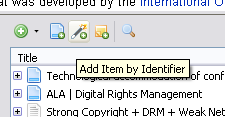
Zotero will add PDFs to your citations if you get them from databases. However, you can also add PDFs that you've already downloaded, and Zotero will automatically retrieve their citation information.


If you have a book in front of you and you don't want to type in all the information one field at a time, Zotero can download an item's information by its identifier:

The "Notes" tab is a great way to track your own thoughts and mark page numbers and quotations you might want to use later. These notes get filed with your citations in Zotero, but they won't get copied to your bibliography.
If you are interested in creating annotations for an annotated bibliography, Zotero can do that, too:
You can take notes on articles that have been uploaded to Zotero.
First you need to install a Zotero plugin: Better Notes. To install a plugin in Zotero, download its .xpi file to your computer. Then, in Zotero, click “Tools → Add-Ons”, then drag the .xpi for the plugin onto the Add-Ons window that opens.
(Get the .xpi file from the release page here: https://github.com/windingwind/zotero-better-notes/releases Use CTRL+F xpi to find the file on this page)
Once Better notes is installed, double click on the PDF title to open it in the Workspace to view. Use the highlight tool to create notes . Notes will appear on the left side of the screen.
Once you highlight some text, click on the yellow five point symbol in the upper right of the note. The text will appear in a pop-up window. This converts your highlight into text and allows you to import it into Word. Use the three dot menu next to the yellow five point symbol to edit or delete your note.

In Word, place your cursor where you want your Note to appear. On the Zotero tab click the "Add Note" where you want your note text to be. A pop-up window of the notes in Zotero will appear. Select the relevant Note.